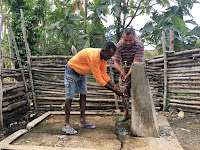It’s about 10 meters long and 10 meters wide, it’s unavoidable and it’s infamous. It’s outside the Rove Police Station in Honiara (Solomon Islands) and it’s the reason why it takes over an hour to travel 6km home.
There is only one road through Honiara, west to east, and this is a section of it. So, when, because of the latest downpour it takes on the nature of steroid infused swiss cheese, when there are more potholes, (that is, craters) than there is road – drivers are forced to a go-slow – around, through and head on - in both directions. Until, one day the road is graded and, while it could not be called ‘carpet road’ it is flat and easily navigable.
There is now need for excessive caution or potential head on collision at 5 km/h and yet despite the fix, drivers still go slow, and meander erratically - as a result there is still a backup of traffic.
There is only one road through Honiara, west to east, and this is a section of it. So, when, because of the latest downpour it takes on the nature of steroid infused swiss cheese, when there are more potholes, (that is, craters) than there is road – drivers are forced to a go-slow – around, through and head on - in both directions. Until, one day the road is graded and, while it could not be called ‘carpet road’ it is flat and easily navigable.
There is now need for excessive caution or potential head on collision at 5 km/h and yet despite the fix, drivers still go slow, and meander erratically - as a result there is still a backup of traffic.
I have plenty of time to contemplate the pothole, and I wonder: are there some lessons to learn from the pothole for the industry in which I work? I think of a couple:
1. The road is apparently a never-ending cycle of repair and despair. Instead of a once and for all fix more sand and gravel is tipped in and flattened down; for a time it looks and feels good. The art of the quick fix.
If only it were that easy and yet despite the logic and the benefit of experience we do the same in the world of aid and development. It is so much easier and quicker, and often looks good on the nightly media round-up to lay down some dollars – feed some people, build a facility, pay off some debt.
To fix the root cause and to invest in the foundation takes more time, more effort and potentially upsets some power holders. It is so much easier, and cheaper, to avoid upsetting the system and just fill in the potholes. Even if changing the system, addressing the root cause, building strong foundations, (sealing the road) could result in sustained and beneficial life change, (and in the end actually be cheaper).
2. What fascinates me about the driving conditions after the road repair is that despite the fix drivers still slow down to crawl through as though nothing has changed. What does it take for people to trust the fix after so many false starts?
People are desperate for help, desperate for hope - but frightened to trust, frightened to believe that anything has changed. Do people just become so used to the way life is that even when they can see a fix they are more comfortable being cautious? Making things look good is easy, changing behaviours is the harder route – it requires a reason, time and trust.
Until we can convince people that the fix, and we, can be trusted why should they change their behaviour? (And here in Honiara, all we have proved is that the road fix cannot be trusted – two days after the fix the road is as bad as ever as the rain washes away the fill.)
Our job is to push back against the quick fix with the associated media grab and brand boost. There will be no lasting hope without trust and there can be no trust without results.
















